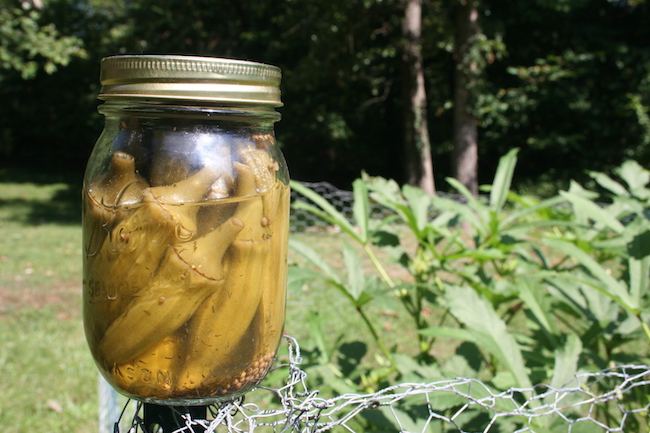One of the first vegetables I learned to process in the canner was pickled okra.
“Hey, bring in the ladder from the garden,” said my husband to baby boy.
“Why did he need the ladder?” I asked.
“To pick the okra,” he answered.
Granted, that was a few years ago and said boy is now taller than the okra, but I can’t help but think about the little guy that we used to send out for the daily picking of the okra a few years ago — especially when I find myself gazing out the kitchen window at the patch of okra now standing in the raised bed garden.
Shelves in the wine cellar, aka basement closet, will soon fill up with jars of this incredibly weird-looking, green vegetable. At least, I think it’s a vegetable.
 I first tasted pickled okra in the Ozarks about 30 years ago. Not that I specifically remember the first day I ever ate okra – thankfully, my life has more zest than that – but, I do know that I’d never seen a stalk of okra in South Dakota before I came down here to check out this lifestyle. After that first tasting experience, I started growing okra and picking okra and pickling okra. My mother-in-law gave me her pickled okra recipe, and I’ve included it in this week’s Food Plot.
I first tasted pickled okra in the Ozarks about 30 years ago. Not that I specifically remember the first day I ever ate okra – thankfully, my life has more zest than that – but, I do know that I’d never seen a stalk of okra in South Dakota before I came down here to check out this lifestyle. After that first tasting experience, I started growing okra and picking okra and pickling okra. My mother-in-law gave me her pickled okra recipe, and I’ve included it in this week’s Food Plot.
It wasn’t long after that first bumper crop came in, that I realized how much time it takes to process this stuff. This year, I can’t help but think about the women of days gone by and how pressured they must have felt during this time of year.
I spoke at length one time with Mae Kinsey, an elderly woman who became a real pal of mine when I worked as an editor of a weekly newspaper in her town. We talked about how mothers worked on farms, getting harvests put up before winter.
First, we talked about cold canning, before the days of pectin products. Mae’s mother would “cook, and cook and cook” the fruit down – loaded with sugar – until it reached the stage of a form of a ball in ice water. Mae said her mother made corncob jelly, which ranked at the bottom of her list of favorite jelly flavors.
The women used woodstoves, and Mae said her husband’s mom worked in a separate kitchen in the smokehouse. Her mom worked outside. Since lids took a big bite out of the budget back then, wax because the standard sealing unit. I even remember chewing that stuff in my grandmas’ kitchens during canning season. There’s no comparison between today’s gum and the short-lived flavor of the wax gym freshly lifted from a new jar of jelly.
Kids played an important part, according to Mae, in the whole putting-up-the-garden process. If moms made apple butter, the kids stood and stirred the copper pot of hot, slimy goo. Another distasteful job occurred when the cabbages came in by wagonload. Mae’s mother would be up at the crack of dawn shredding the cabbage for sauerkraut. The cabbage would then be heavily salted and stored in a hug stone jar. A kid would be sent out to find a big rock to put on the plate on top of the cabbage. A kid also had to take the leftover cabbage leaves to the hogs, which ranked low on Mae’s list of chores.
Some fruits and vegetables never made it into jars. Families often stored turnips, potatoes and other root vegetables in bins in the cellar. If the cellar filled up, the back yard provided more storage spots. Mae remembered digging wide holes in the back yard and placing straw in the holes. Then, they placed cabbages, turnips and apples into the holes, followed by more straw and then, dirt on the top. Mae recalled running out to dig up food for her mother and she remembered eating apples at Christmas that came out of the ground.
“Jars were everywhere,” said Mae. With 10 children to feed – interestingly in boy-girl order down the line – her mother must have canned and pickled hundreds of pounds of food.
Meat met the jars, too. Mae’s husband, Guy, said, “Everything but the squeal” got extracted from a butchering session.
With all the hard work involved in keeping a family fed, the Kinseys looked back on those days wondering how their mothers managed to work so hard. They remembered that food tasted especially good and when they came home from school, there would always be a biscuit or a piece of cornbread or maybe a slice of bacon in the warming oven on the stovetop. And, mom was there, too.
So, for all you out here who are carrying on the tradition of canning and pickling for your friends and families, here’s a green, vinegary-fingered salute. And remember, most of us can’t stand the heat in the canning kitchen anymore, but we all still appreciate the efforts.
Publisher/Editor Barbara Baird is a freelance writer in hunting, shooting and outdoor markets. Her bylines are found at several top hunting and shooting publications. She also is a travel writer, and you can follow her at https://www.ozarkian.com. View all posts by Barbara Baird
Barb,
That certainly brought back a ton of memories. Thanks for a GREAT article!
Tammy
Well, I’m glad that your life has had more “zest” than pickled okra!